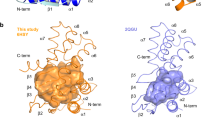Abstract
Pseudomonas aeruginosa expresses hemolytic phospholipase C (PlcH) with choline or under phosphate-limiting conditions. PlcH from these conditions were differently eluted from the Celite-545 column after application of an ammonium sulfate linear reverse gradient. The PlcH from supernatants of bacteria grown in the presence of choline was eluted with 30% ammonium sulfate and was more than 85% inhibited by tetradecyltrimethylammonium. PlcH from supernatants of bacteria grown with succinate and ammonium ions in a low-phosphate medium was eluted as a peak with 10% of salt and was less than 10% inhibited by tetradecyltrimethylammonium. PlcH from low phosphate was purified associated with a protein of 17 kDa. This complex was dissociated and separated on a Sephacryl S-200 column with 1% (w/v) sodium dodecyl sulfate. After this dissociation, the resulting protein of 70 kDa, corresponding to PlcH, was inhibited by tetradecyltrimethylammonium, showing a protection effect of the accompanying protein. RT-PCR analyses showed that in choline media, the plcH gene was expressed independently of plcR. In low-phosphate medium, the plcH gene was expressed as a plcHR operon. Because plcR encodes for chaperone proteins, this result correlates with the observation that PlcH from supernatants of bacteria grown in the presence of choline was purified without an accompanying protein. The consequence of the absence of this chaperone was that tetradecyltrimethylammonium inhibited the PlcH activity.





Similar content being viewed by others
References
Bradford MN (1976) A rapid and sensitive method for the quantitation of microgram quantities of protein utilizing the principle of protein dye binding. Anal Biochem 72:248–254
Cota-Gomez A, Vasil AI, Kadurugamuwa J, et al. (1997) PLcR1 and PLcR2 are putative calcium-binding proteins required for secretion of the hemolytic phospholipase C of Pseudomonas aeruginosa. Infect Immun 65:2904–2913
Garfin D (1990) One-dimensional gel electrophoresis. Methods Enzymol 182:425–441
Johnson MK, Boese Marrazo D (1980) Production and properties of heat-stable extracellular hemolysin from Pseudomonas aeruginosa. Infect Inmun 29:1028–1033
Laemmli UK (1970) Cleavage of structural proteins during the assembly of head of bacteriophage T4. Nature 227:680–685
Leoni L, Ciervo A, Orsi N, et al. (1996) Iron-regulated transcription of the pvdA gene in Pseudomonas aeruginosa: effect of Fur and PvdS on promotor activity. J Bacteriol 178:2299–2313
Lisa AT, Garrido MN, Domenech CE (1984) Pseudomonas aeruginosa acid phosphatase and cholinesterase induced by choline and its metabolic derivatives may contain a similar anionic peripheral site. Mol Cell Biochem 63:113–118
Lisa AT, Lucchesi GI, Domenech CE (1994) Pathogenicity of Pseudomonas aeruginosa and its relationship to the choline metabolism through the action of cholinesterase, acid phosphatase an phospholipase C. Curr Microbiol 29:193–199
Luberto C, Stonehouse MJ, Collins EA, et al. (2003) Purification, characterization and identification of a sphingomyelin synthase from Pseudomonas aeruginosa. PlcH: a multifunctional enzyme. J Biol Chem. 278:32,733–32,743
Lucchesi GI, Domenech CE (1994) A simple and reliable method for the purification of Pseudomonas aeruginosa phospholipase C produced in high phosphate medium containing choline. Int J Biochem 26:155–162
Lucchesi GI, Lisa AT, Domenech CE (1989) Choline and betaine as inducer agents of Pseudomonas aeruginosa phospholipase C activity in high-phosphate medium. FEMS Microbiol Lett 57:335–338
Lucchesi GI, Lisa TA, Casale CH, et al. (1995) Carnitine resembles choline in the induction of cholinesterase, acid phosphatase, and phospholipase C and its action as an osmoprotectant in P. aeruginosa. Curr Microbiol 30:55–60
Majtán V, Hoštacká A, Mlynarčík D, et al. (1995) Suppression of virulence factors of Pseudomonas aeruginosa by subinhibitory concentrations of quaternary ammonium salts. Drug Res 45:327–330
Majtán V, Majtánová L, Hoštacká A, et al. (1995) Effect of quaternary ammonium salts and amine oxides on Pseudomonas aeruginosa. Microbios 84:41–51
Okino N, Ito M (2007) Ceramidase enhances phospholipase C-induced hemolysis by Pseudomonas aeruginosa. J Biol Chem. 282:6021–6030
Sage AE, Vasil ML (1997) Osmoprotectant-dependent expression of plcH, encoding the hemolytic phospholipase C, is subject to novel catabolite repression control in Pseudomonas aeruginosa PAO1. J Bacteriol 179:4874–4881
Sambrook J, Russel DW (2001) Molecular cloning: A laboratory manual. In: Nolan C (ed). Cold Spring Harbor Laboratory Press, Cold Spring Harbor, NY
Snyder A, Vasil AI, Zajdowicz SL, et al. (2006) Role of the Pseudomonas aeruginosa PlcH Tat signal peptide in protein secretion, transcription, and cross-species Tat secretion system compatibility. J Bacteriol 188:1762–1774
Stonehouse MJ, Cota-Gomez A, Parker SK, et al. (2002) A novel class of microbial phosphocholine-specific phospholipases C. Mol Microbiol 46:661–676
Vasil M, Vasil A, Shortridge V (1994) Phosphate and osmoprotectants in the pathogenesis of Pseudomonas aeruginosa. In: Torriani-Gorrini EYA, Silver S (eds) Phosphate in microorganisms: Cellular and molecular biology. American Society for Microbiology, Washington, DC, pp.126–132
Woods DE, Cryz SJ, Friedman RL, et al. (1982) Contribution of toxin A and elastase to virulence of Pseudomonas aeruginosa in chronic lung infections in rats. Infect Immun 36:1223–122
Acknowledgments
This work was supported by grants from ANPCyT-UNRC, CONICET, and SECYT–UNRC of Argentina. CED, ATL, and GIL are Career Members of the Consejo Nacional de Investigaciones Científicas y Técnicas (CONICET) of Argentina. ASL has a fellowship from Agencia Córdoba Ciencia-CONICET and MJM and MAF have fellowships from CONICET.
Author information
Authors and Affiliations
Corresponding author
Rights and permissions
About this article
Cite this article
Liffourrena, A.S., Massimelli, M.J., Forrellad, M.A. et al. Tetradecyltrimethylammonium Inhibits Pseudomonas aeruginosa Hemolytic Phospholipase C Induced by Choline. Curr Microbiol 55, 530–536 (2007). https://doi.org/10.1007/s00284-007-9027-2
Received:
Accepted:
Published:
Issue Date:
DOI: https://doi.org/10.1007/s00284-007-9027-2



